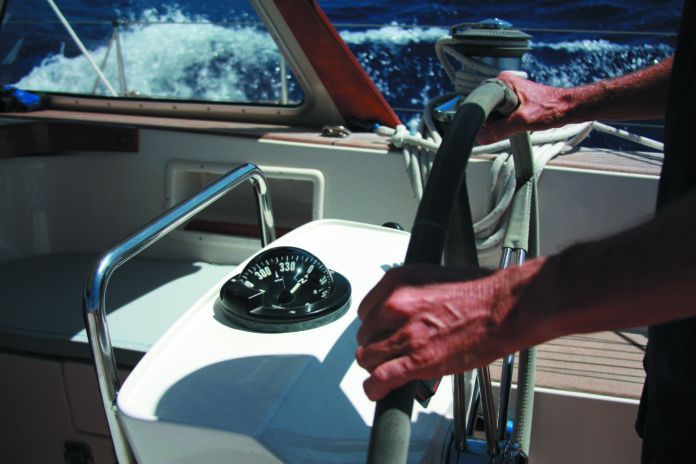When high-pressure dominates, it is normal for the wind direction to oscillate 15-20 degrees every 5-20 minutes. In theory, hitting the shifts correctly will increase the distance made good to windward by 20-30 percent. Racers obsess over hitting these shifts and new technology allows them to do it better than ever, but if your boat is set up to tack efficiently, it’s a fun game that the low-tech cruiser can play as well.
Watch either the compass or landmarks— not your GPS—as you begin working your way to windward. Is there a steady back and forth that suggests the wind is trying to make up its mind? If you observe this cycle more than a few times, tack when the wind heads (becomes more on the nose) by more than about 5 degrees, indicating the start of a shift. Remember that the average wind direction—what we call a persistent shift—will change during the day as well.
Jibing on shifts can work for boats that sail hot angles (jibing through more than 70 degrees). However, since most cruising boats sail deeper angles, the benefits of following oscillations are less than sailing to windward. Normally, it’s better to simply bear off in the puffs, head up in the lulls and jibe on persistent shifts. One downside of jibing on shifts is that you cannot set a preventer and thus cannot sail too deeply without risking an accidental jibe.
A simple but effective strategy, useful in both shifty winds and running down a gently winding river (which causes the wind direction to change) is to alternate between broad reaching and running wing-and-wing. Only one sail needs to jibe, making it easy and efficient in light to moderate winds.
CATS PAWS
In gusty conditions, particularly when the air is warmer than the water, the wind descends from above, penetrating a stable boundary layer and then radiating outwards from the impact point. In light conditions these downdrafts may hold the only fun wind, and in stronger conditions you may want to avoid them.
One thing is certain; the wind will change, and you must decide whether you want to tack to one side to benefit from a potential lift, or sail into the center and take your chances with increase wind pressure. In light winds, the center is probably best, in strong winds, tacking up the side may give both a lift and less wind.
CLOUDS
Falling rain creates downdrafts which fan radially outwards from the cloud, forming a gust front. If black thunderstorm clouds are present, drastically reducing or dousing all sail may be the best strategy (see Inside PS blog “Squall Tips for Sailors”).
However, if it is a day of patchy light to moderate rain, you can use this outflow pattern to boost your sailing. (If you can see through the squall, any gusts are likely to be moderate.) There will be greater wind on the windward side of the clouds, and less wind on the leeward side. Differences of 5-10 knots are typical with light to moderate rain, but anything is possible with a super cell.
Patchy cumulous clouds, on the other hand, generate updrafts. Warm air from the surface rises, causing a surface wind flowing towards the cloud. The leeward side of the cloud can have dramatically reduced wind, while the windward side has increased flow. By timing tacks and jibes to dodge between and follow behind (to windward of) these clouds, differences of 2-5 knots are typical.








































